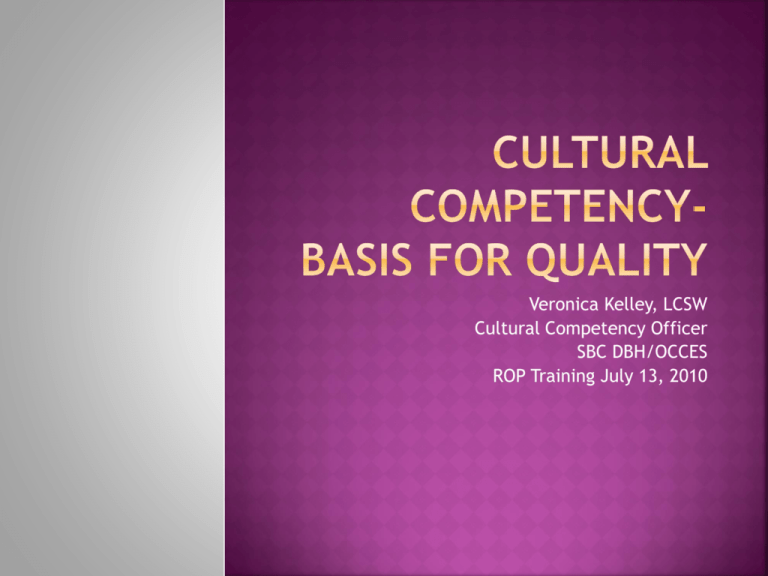San Bernardino County ROP Training Presentation
advertisement

Veronica Kelley, LCSW Cultural Competency Officer SBC DBH/OCCES ROP Training July 13, 2010 Providing services in a way that makes sense to the person/s you are providing it to. Culture: Any group that shares beliefs, values, norms Competent: to do… Ability Congruent set of practice skills, knowledge, behaviors, attitudes & policies that come together in a system, agency or among providers and pros that enables that system to work effectively cross culturallyCross et al, 1989 It is the right thing to do Services aren't quality if they aren't culturally appropriate It is also the law Title VI of the Civil Rights Act of 1964 “no person in the United States shall on the ground of race, color or national origin be excluded from participation in, denied the benefits of, or be subjected to discrimination under any program or activity receiving federal financial assistance” (42 U.S.C. 200d) Also prohibits recipients of federal funds from providing services to LEP persons that limited in scope or lower in quality than those provided to others. Executive 13160 Order Non discrimination on the basis of race, sex, color, national origin, disability, religion, age, sexual orientation and the status as a parent in Federally conducted Education and Training programs California Educational Code 221.5-231.5- Sex Equity in Education 8230-8233- Migrant Children Education 8850.5-Family relationships and Parenting Education* 1300-CA. Public Civil Liberties Act* Family values can be varied Majority culture American education system easier to comprehend Focus generally on independence/autonomy/success of self Family system may be more traditional to native country traditions/beliefs Parental unit may be working multiple jobs May be paternal authority with maternal responsibility If newer arrival, may be monolingual parents Extended family Value education Can be of African Heritage/Caribbean/Black Family system extended Long history of bias negatively impacting black children, especially boys Maternal responsibility/authority Value education Stigma extends to everyone in family/community Obedience to parents Intergenerational stress Long history of trauma with school system Distrust with majority system Family systems are very extended Many may include indigenous practices/stories, etc. In closing; you must understand the make up and culture of your students in order to provide them a more effective educational experience. Formal education will make you a living; self education will make you a fortune~ John Rohn San Bernardino County Department of Behavioral Health Alcohol and Drug Disorders 101 Presented by Gary R. Atkins, M.S.W. Deputy Director, Program Operations, Alcohol and Drug Services 268 W. Hospitality Lane, Suite 400 San Bernardino, CA 92415 San Bernardino County Department of Behavioral Health Elements of Addiction Pre-Addiction Family Issues Peer Pressure Child Abuse/Neglect Trauma Bio-chemistry Environment San Bernardino County Department of Behavioral Health Elements of Addiction Pre-Addiction Family Issues Peer Pressure Child Abuse/Neglect Trauma Bio-chemistry Environment San Bernardino County Department of Behavioral Health Elements of Addiction Pre-Addiction Family Issues Peer Pressure Child Abuse/Neglect Trauma Bio-chemistry Environment Alcohol and Drug Services Administration The Chronic Care and Recovery Support Framework Gary Atkins, MSW Deputy Director of Program Operations County of San Bernardino Department of Behavioral Health OBJECTIVES • To transform to a chronic care model for Behavioral Health Services. • To build unity across the alcohol and drug field. • To promote and understand the Institute of Medicine’s Chronic Care Framework. • To develop and implement ideas for systems integration and transformation. County of San Bernardino Department of Behavioral Health Creating the Roadmap for the Chronic Care and Recovery Support Framework County of San Bernardino Department of Behavioral Health Current Prevention Services Seven Contracted Environmental Prevention Providers Applied Research and Data Media Advocacy Community Organization Enforcement Policy Development County of San Bernardino Department of Behavioral Health Current Alcohol and Drug Treatment Services 29 2 DETOX CLINICS OUTPATIENT CLINICS 7 RESIDENTIAL CLINICS 13 PC 1000 PROGRAMS 9 6 DRUG COURTS 14 DUI PROGRAMS RECOVERY CENTERS County of San Bernardino Department of Behavioral Health A substance abuse treatment service system should be designed … • With the understanding that addiction is a chronic disease. • Relapse is likely to happen, especially in early stages of recovery. • Clients have individual and multiple needs, therefore a continuum of care is necessary. County of San Bernardino Department of Behavioral Health 24 CREATING AN INTEGRATED QUALITY BASED TREATMENT SYSTEM Unified Leadership Evidenced based practices • Data Collection • System Evaluation • Accountability for Measurable Outcomes Collaboration Among Systems Regulate Facilities • Program Quality • Health and Safety Provide regular feedback to providers regarding outcomes and advancement of the field. County of San Bernardino Department of Behavioral Health 25 In Summary… • OUTCOME DATA WILL SHOW PROGRESS. • CHANGE IS GOOD, AND NEEDED… • FUNDING, ALWAYS AN ISSUE TO OVERCOME… CAN BE AN OPPORUNITY TO REFRAME THE FUTURE… County of San Bernardino Department of Behavioral Health THE BIG PICTURE THANK YOU… Gary Atkins, MSW Deputy Director of Program Operations Department of Behavioral Health County of San Bernardino (909) 382-3079 gatkins@dbh.sbcounty.gov County of San Bernardino Department of Behavioral Health





